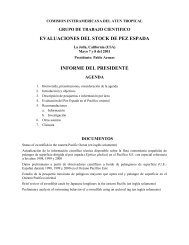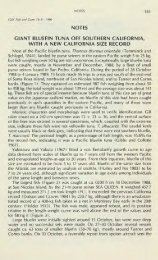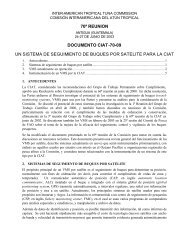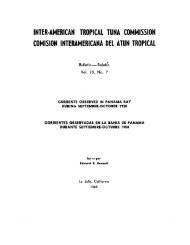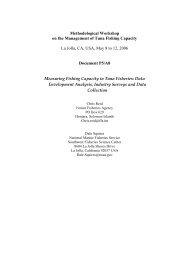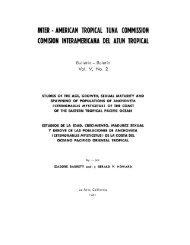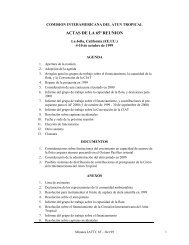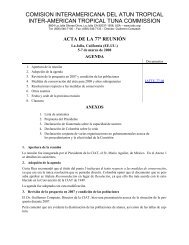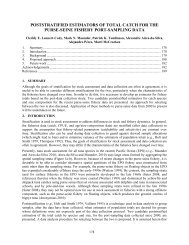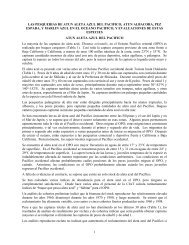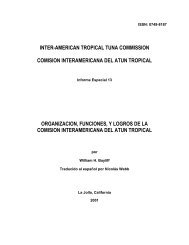Informe Anual de la Comisión Interamericana del Atún Tropical, 19
Informe Anual de la Comisión Interamericana del Atún Tropical, 19
Informe Anual de la Comisión Interamericana del Atún Tropical, 19
You also want an ePaper? Increase the reach of your titles
YUMPU automatically turns print PDFs into web optimized ePapers that Google loves.
ANNUAL REPORT <strong>19</strong>87<br />
example, the X83 and Y83 cohorts (diagonallines), which were both re<strong>la</strong>tively strong, were not fished<br />
heavily until<strong>19</strong>85, when they were in age-group 3and their biomass was high. The Y73 cohort, on the<br />
other hand, was only average, and after having been fished heavily as age group-1 fish in <strong>19</strong>73 its<br />
biomass was low in the succeeding years.<br />
In Figure 33 are shown the average quarterly and annual biomass estimates for <strong>19</strong>68 through<br />
<strong>19</strong>87 for aH fish regardless of age and for "<strong>la</strong>rge fish" (aH Y-cohort fish which had been in the fishery<br />
more than six quarters plus aH X-cohort fish which had been in the fishery more than eight<br />
quarters). The data for <strong>19</strong>64-<strong>19</strong>67 are not shown because during that period the area offishing in the<br />
CYRA was still expanding and the cohort biomass estimates for those years are biased downward.<br />
During <strong>19</strong>68-<strong>19</strong>71 the total biomass averaged about 350 thousand tons. This was comprised ofa<strong>la</strong>rge<br />
proportion of ol<strong>de</strong>r fish resulting from the fish of the aboye-average <strong>19</strong>66 and <strong>19</strong>67 recruitments<br />
which were exploited lightly as young fish. Below-average recruitment, coupled with increasing<br />
exploitation rates during <strong>19</strong>69-<strong>19</strong>72, resulted in a <strong>de</strong>cline in the biomass during <strong>19</strong>72 and <strong>19</strong>73 of<br />
both the younger and ol<strong>de</strong>r fish. The lower biomass ofol<strong>de</strong>r fish persisted through <strong>19</strong>74, whereas the<br />
abundance of smaHer fish increased in <strong>19</strong>74 as a result of an extremely <strong>la</strong>rge <strong>19</strong>74 year c<strong>la</strong>ss. That<br />
year c<strong>la</strong>ss accounted for most ofthe increase in biomass of<strong>la</strong>rge fish in <strong>la</strong>te <strong>19</strong>75, all of<strong>19</strong>76, and early<br />
<strong>19</strong>77. The fourth-Iargest catch ofyellowfin insi<strong>de</strong> the CYRA in the history ofthe fishery was ma<strong>de</strong><br />
during <strong>19</strong>76. Below-average recruitment during <strong>19</strong>76 and <strong>19</strong>77, coupled with heavy exploitation of<br />
young fish from <strong>19</strong>73 to <strong>19</strong>82, resulted in the biomass ofboth young and old fish <strong>de</strong>creasing in <strong>19</strong>82 to<br />
the lowest level observed. Although the <strong>19</strong>78 and <strong>19</strong>79 recruitments were high, the former excee<strong>de</strong>d<br />
only by that of <strong>19</strong>74, so many of the fish were captured as 1-and 2-year-olds that they did not<br />
contribute heavily to the fishery in <strong>19</strong>81 or <strong>19</strong>82. The recruitment was average in <strong>19</strong>80, slightly aboye<br />
average in <strong>19</strong>81 and <strong>19</strong>83, below average in <strong>19</strong>82, and well aboye average in <strong>19</strong>84, <strong>19</strong>85, and <strong>19</strong>86. Not<br />
only were the <strong>19</strong>84-<strong>19</strong>86 recruitments high, but together they produced the greatest combined<br />
recruitment on record (about 25 percent greater than the average combination ofthree years for the<br />
<strong>19</strong>67-<strong>19</strong>87 period). The biomass increased in <strong>19</strong>83 (Figure 33), due primarily to lesser fishing effort,<br />
and greatly increased in <strong>19</strong>84 and <strong>19</strong>85 due to good recruitment and reduced fishing on young fish.<br />
The benefits from the <strong>19</strong>84-<strong>19</strong>86 recruitment continued into <strong>19</strong>87, in spite ofthe <strong>la</strong>rge increase in the<br />
catch. Preliminary estimates of the <strong>19</strong>87 recruitment indicate that it was aboye average.<br />
The annual catches, in short tons, offish ofthe Xand Ycohorts, and ofboth cohorts combined,<br />
during <strong>19</strong>68-<strong>19</strong>87 are shown in Figures 34 and 35. In Figure 34 each panel contains the catches of<br />
fish ofdifferent cohorts in the same year, whereas in Figure 35 each panel contains the catches offish<br />
of the same cohort in different years.<br />
Comparison of Figures 32 (annual estimates of the biomass of the X and Y groups), 33<br />
(quarterly and annual estimates ofthe total biomass and the biomass of<strong>la</strong>rge fish), and 34 and 35<br />
(catches during each year by age and cohort) reveals the changes which have taken p<strong>la</strong>ce in the age<br />
composition of the popu<strong>la</strong>tion and the catch. During the <strong>19</strong>70s, when the fishing effort was high,<br />
fewer and fewer individuals survived to reach the <strong>la</strong>rger sizes. The fishing effort was reduced in <strong>19</strong>82,<br />
<strong>19</strong>83, and <strong>19</strong>84, which permitted many fish which would have been caught while young to grow<br />
<strong>la</strong>rger. The total contributions ofeach Xand Ycohort to the fishery have been estimated for the <strong>19</strong>68<br />
through <strong>19</strong>83 cohorts, using the data in Table 20, and these are shown in Figure 35. They ranged<br />
from 121 thousand tons for the <strong>19</strong>70 cohort to 268 thousand tons for that of<strong>19</strong>74, with an average for<br />
the 16 groups of161 thousand tons. Ifthe Y74 cohort had not been fished so heavily in its first year the<br />
catches for that cohort would have been even greater. Division ofthese cohort catches (<strong>19</strong>68-<strong>19</strong>83) by<br />
the corresponding estimates of recruitment (values in Table <strong>19</strong>B adjusted to the initial numbers)<br />
gives yield-per-recruit estimates which varied from 4.2 to 7.6 pounds, (1.9 to 3.4 kg). The initial<br />
recruitment varied from 32 million to 92 million fish, averaging 54 million fish, and produced an<br />
average yield per recruit of 5.9 pounds (2.7 kg).<br />
43



